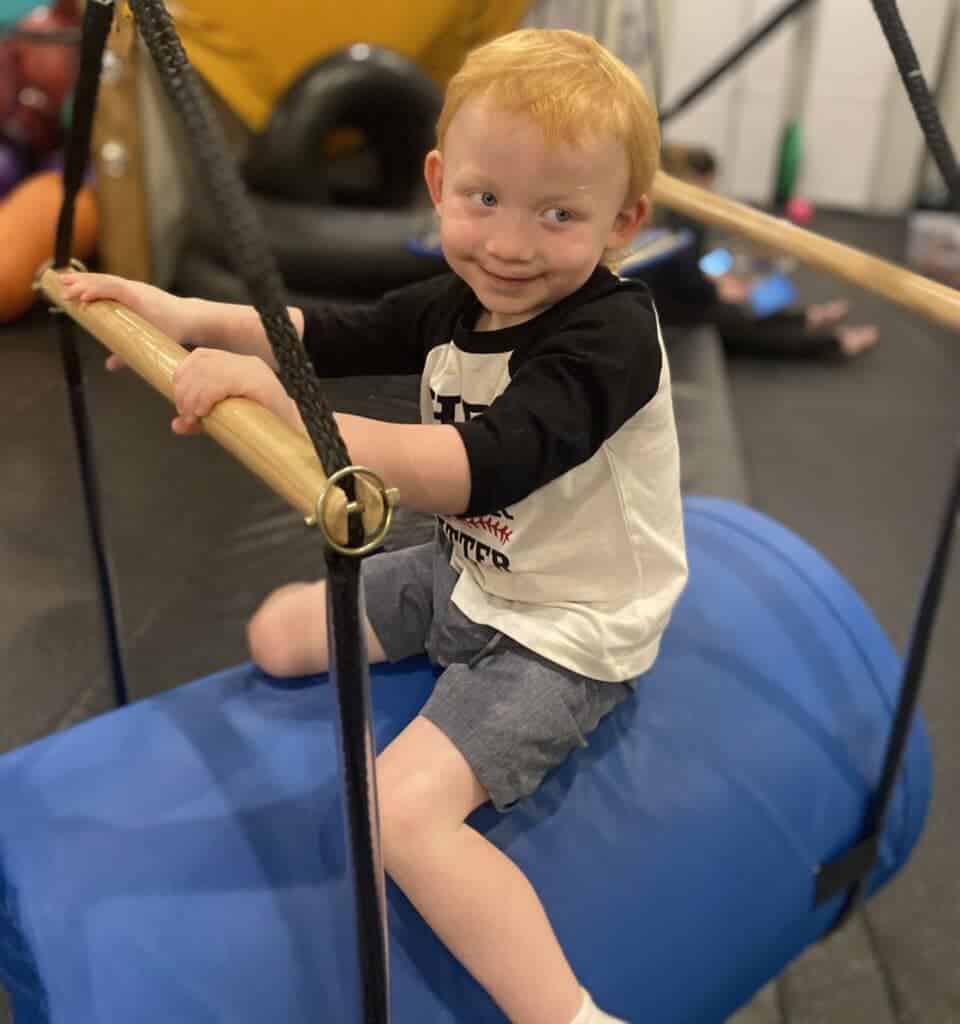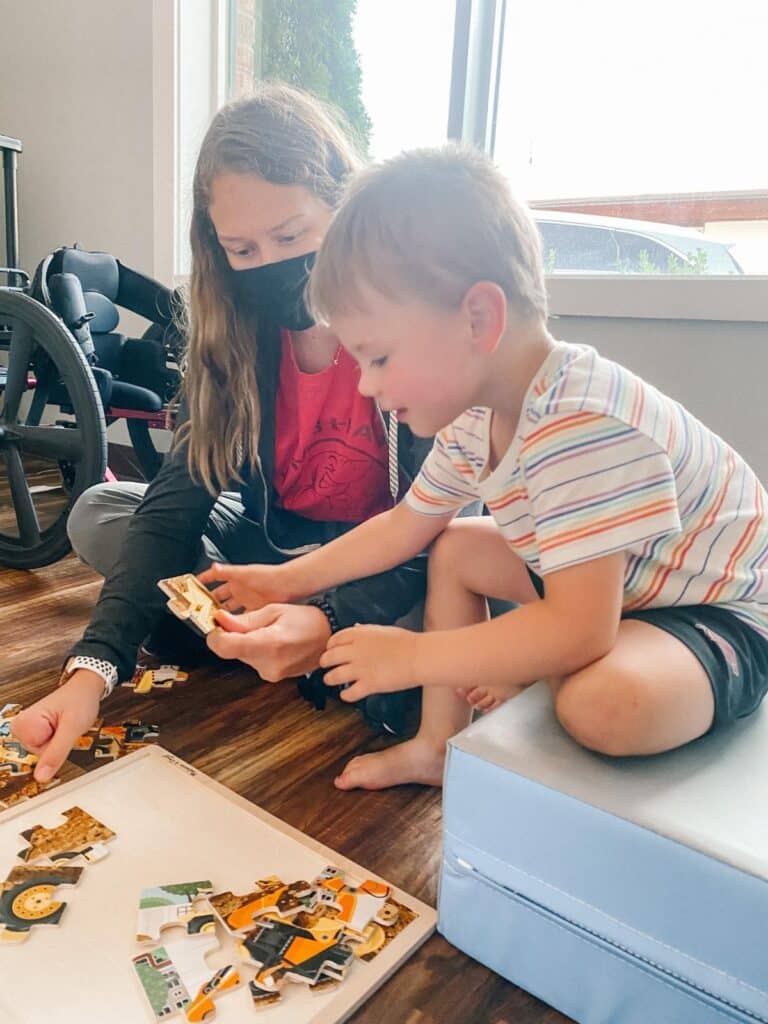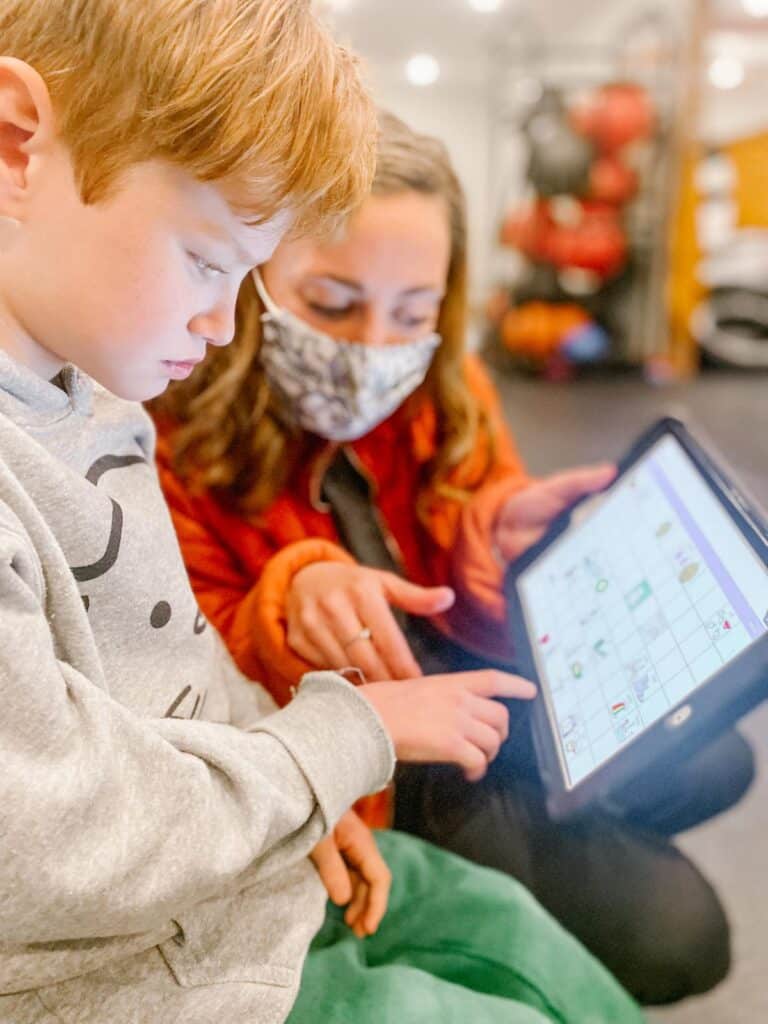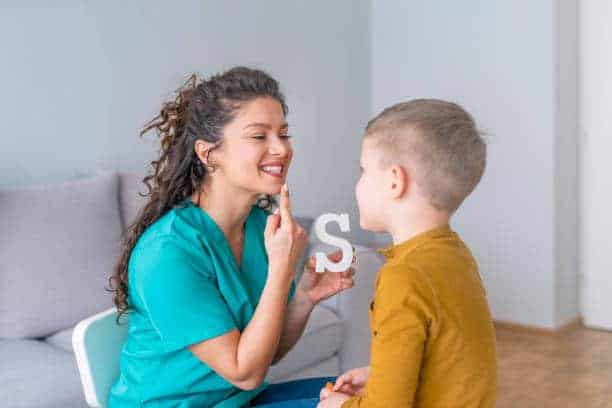Gross Motor Milestones: A Guide for Parents from a Pediatric Physical Therapist

As a pediatric physical therapist, one of the most common queries I encounter is, “Is my child on track with their physical development?” Understanding gross motor milestones and knowing when it might be time to seek professional guidance is vital for every parent. Here’s a concise guide to help you navigate this essential aspect of your child’s growth. What are Gross Motor Milestones? Gross motor milestones are the significant stages of physical development in a child’s life, starting from infancy to their early school years. They encompass skills involving large muscle movements of the body—think crawling, walking, jumping, and running. Key Gross Motor Milestones: 1. Birth to 3 months: – Baby begins to lift the head during tummy time. – Gradual improvement in head control. 2. 4 to 6 months: – Rolling over (from tummy to back and vice versa). – Sitting with support and starting to sit independently. 3. 7 to 9 months: – Starts to crawl. – Pulls to stand with support. 4. 10 to 12 months: – Begins to stand without support. – May take first independent steps. 5. 1 to 2 years: – Walks independently and starts to run. – Begins to climb stairs with support. 6. 2 to 3 years: – Runs confidently and starts to jump. – Climbs stairs one at a time without holding on. 7. 3 to 5 years: – Begins hopping, swinging, and maybe even skipping. – Rides a tricycle and stands on one foot for a short time. When to Seek a Referral: While every child develops at their own unique pace, there are general timeframes in which most children acquire these skills. It’s essential to remember that occasional delays are typical. However, if you observe the following, it may be time to seek a referral: 1. Consistent Delays: If your child is regularly missing milestones or is significantly behind their peers. 2. Loss of Skills: Any regression, like a child who once walked but now doesn’t, warrants a check. 3. Lack of Coordination: If your child appears unusually clumsy for their age or struggles more than their peers with similar activities. 4. Uneven Muscle Use: For instance, if your child uses one side of their body more than the other. 5. Difficulty in Keeping Up: If they struggle to engage in age-appropriate activities or play due to physical constraints. Your child’s health and well-being are paramount. Being proactive and seeking guidance when unsure can make all the difference. Trust your instincts as a parent, but also remember to seek expert advice when needed. Pediatric physical therapists are here to assist, guide, and provide the necessary interventions to ensure your child’s optimal physical development.
The Benefits of Early Intervention in Pediatric Therapy

Early intervention in pediatric occupational, physical and speech therapy services is a proactive and essential approach to supporting children’s development and addressing potential challenges at an early age. There are numerous benefits of early intervention in pediatric therapy, which can have a very positive impact on a child’s overall growth and future success. Timely Identification of Developmental Delays and Challenges: Early intervention allows for the timely identification of developmental delays and challenges in children. By identifying these challenges early on, therapists and parents can work together to create targeted intervention plans tailored to the child’s specific needs. Optimal Brain Plasticity and Learning: During early childhood, the brain is incredibly malleable, exhibiting a high degree of neuroplasticity. This simply means the brain is pliable, and has the ability to change. Intervening during this crucial period maximizes the brain’s ability to adapt and learn, leading to more positive outcomes in various developmental areas. Improved Long-Term Outcomes: Research consistently shows that children who receive early intervention in pediatric therapy achieve better long-term outcomes compared to those who do not. Early support in OT, PT and Speech Therapy can lead to improved academic performance, social skills, and overall independence in daily living. Family Involvement and Empowerment: Early intervention is not just about the child; it involves the entire family. Therapists work closely with parents and caregivers, empowering them with knowledge, strategies, and resources to support their child’s development effectively. It is important that we are always collaborating with each individual and their family to best serve the client’s needs and provide the right support to their families. By providing support and resources, therapy helps reduce stress and anxiety for parents and caregivers, promoting a more supportive and nurturing environment for the child. Enhancing Social and Communication Skills: Early intervention can significantly impact a child’s social and communication skills. Therapists use various evidence-based approaches to foster language development, social interactions, and emotional regulation in young children. Some of these examples include AAC devices, PEC systems, and play opportunities with others including imitative, parallel and reciprocal play activities. Addressing Sensory Processing Issues: Sensory processing challenges can significantly impact a child’s daily life. Early intervention helps identify and address these issues, enabling the child to better process sensory information and be able to attend, focus and engage in various activities with confidence across all of their environments. Building Self-Confidence and Resilience: Children who receive early intervention support often develop higher levels of self-confidence and resilience. As they see their progress, they gain a sense of accomplishment and belief in their abilities, which positively impacts their overall self-esteem. Early intervention in pediatric therapy is a powerful tool that can positively influence a child’s development and future. By identifying challenges early, involving families, and providing targeted support, we can help set children on a path to success and help them reach their full potential. Our occupational, physical and speech therapists play a crucial role in shaping the lives of young children, enabling them to reach and achieve their individual goals, and supporting the families on their journey to continued growth and success.
YES! You can play with your food!

As a child, my parents used to tell me “Don’t play with your food!”…but times have changed! Playing with food is a good thing and allows your child to explore and learn about foods without any pressure to eat the foods presented. Food play allows your child to touch, see, hear, feel and possibly even taste a variety of foods. Playing with food allows them to enter into a sensory experience that can help with sensory sensitivities, picky eating, language development, problem solving, social skills, and regulation skills. Is the food gooey, chunky, slimy, sticky, rough, or smooth? What does the food smell like? What shapes, sizes and colors do you see? Does it make noise when you squish it, play with it, break it, crumble it? Children learn through play! Not to mention, picking up and manipulating food can help promote fine motor skills too. How cool is it that there are so many benefits to playing with food? Moreover, playing with food can make feeding a more fun and positive experience for children who get anxious and stressed when trying new foods. Exploring foods can be incorporated into meal times, but can also be a fun activity during free time or as a creative outlet. Below is a list of food play ideas that kids can enjoy. Over time and with continued exposure through play, they will get to learn all about different foods, become more comfortable with foods, and move towards eating the foods. Food play ideas: Finger paint with yogurt, salsa, hummus, applesauce or other sauces Use paint brushes to paint with pudding or purees Touch and squish wet foods through Ziploc bags Feed their teddy bear or doll during a picnic with real foods Feed any toys with a mouth Make fruit salad/fruit kabobs Create a Mr. Potato Head with real foods Work on counting: Count Cheerios, pieces of fruit, crackers… Create funny faces with foods Stack crackers, cookies, cubes of cheese, and see who can make the tallest tower Match different shaped crackers/foods into categories (e.g., shape, color, size) Build a house, car or other ideas out of crackers, sticks, cheese cubes, etc and peanut butter as the glue Drive cars and diggers through cooked pasta/rice, canned fruit, or yogurt, salsa, or other sauces Ask your child to help prepare the foods when cooking or baking Serve food to others String cheerios or fruit loops and make food jewelry Stir/pour/shake/mix foods and sing songs Make a noise with a food to draw attention to it (e.g., crunch, splat, pop, splash) Make mustaches with foods (e.g., peppers) or glasses (e.g., cucumbers) Flick and Roll foods across the table to play table finger-hockey or soccer with foods Write names/letters in purees or sauces Make letters/numbers from sticks of foods/cooked noodles Remember it’s all about having fun and exploring foods; try not to stress if your child is not eating the food. Add in some music, sunshine or fresh air and enjoy this time playing together with your child!
Physical Therapy vs Occupational Therapy for Children: Understanding the Differences

As a parent or caregiver, you may have heard of both physical therapy and occupational therapy, especially if your child is dealing with a health issue or developmental concern. While both forms of therapy are geared towards improving a child’s quality of life, their approach and focus areas can be quite different. Understanding these differences can help ensure your child gets the most appropriate care for their needs. Physical Therapy (PT) for Children Pediatric physical therapy primarily aims at improving a child’s physical abilities. It focuses on enhancing a child’s gross motor skills, strength, balance, and coordination, especially those necessary for mobility. For instance, a physical therapist might help a child with cerebral palsy learn to walk with assistive devices, or aid a child recovering from a sports injury to regain strength and flexibility. Pediatric physical therapists also play a significant role in early intervention, helping to mitigate developmental delays in infants and toddlers. Occupational Therapy (OT) for Children On the other hand, pediatric occupational therapy focuses on helping children achieve independence in all areas of their lives. It’s centered around improving fine motor skills, cognitive abilities, visual-perceptual skills, and sensory processing abilities that children need for daily activities or “occupations.” In this context, “occupations” refer to the everyday activities that occupy a child’s time, such as dressing, eating, playing, and school-related tasks. For example, an occupational therapist might help a child to improve their handwriting skills or guide a child with sensory processing disorder in managing overstimulation. There is often an overlap between PT and OT, and in many instances, a child may benefit from both services. For instance, a child with a physical disability may work with a physical therapist to improve overall body strength and mobility, while also seeing an occupational therapist to work on specific skills such as dressing or using utensils. Physical therapy and occupational therapy, though different in their focus, are both crucial to promoting healthy development and quality of life in children who need them. A comprehensive understanding of both therapies can help parents advocate for their children and ensure they receive the most appropriate and effective care. Remember, every child is unique, and what works best will depend on their individual needs and circumstances. A discussion with your child’s healthcare provider can provide further guidance on which therapy, or combination of therapies, would be most beneficial for your child.
Speech Dismissals: Was my child dismissed too soon?!

As a parent, coming to terms with the need for therapy can be hard on the heart. However, once your child starts speech therapy, your therapy team becomes a part of your family. Obviously, the ultimate goal is to reach dismissal. Your child has met their current goals and the therapist proudly hands over a certificate of graduation! What a glorious day, or is it? Sometimes, parents may feel that continued therapy would be beneficial. Understanding how your child has reached the point of dismissal is often confusing. Perhaps Johnny still doesn’t say his R sounds or misuses verbs. As a parent, these types of performance errors can cause concern. Here are a few things to consider: Therapists follow specific developmental guidelines, use nationally normed standardized assessments, paired with professional experience to determine when your child is ready to be dismissed. Your child may have many articulation errors when speaking. If the national guidelines show that the errors are acceptable for your child’s age; continued therapy would not be recommended. The majority of children will gain these skills without intervention. Your child may have a mild delay that does not warrant direct therapy but would be better served through home programming. Many parents are able to target skills during daily activities! Your child may need the opportunity to be around peers to gain the skills. For example, many young children show pragmatically unexpected behaviors. As they start school and interact in peer groups, they will learn many skills naturally. Should your child be re-evaluated after dismissal? Here are examples of scenarios where a child that may have received services in the past would benefit from a closer look at skills via a re-evaluation. A child has had ample opportunity to gain social skills via peer groups, family groups, community exposure, and parent modeling; yet continues to be inappropriate and show lack of social awareness: Pragmatic Skills Reassessment Needed A child is age 8, not showing awareness of continued articulation deficit, misarticulates all R sounds, has obvious lisping of S/Z, or misarticulated multiple sounds when speaking. Articulation Skills Reassessment Needed A school-aged child cannot tell you what he/she has read, cannot answer comprehension questions, cannot problem-solve with peers, and/or compromise. Language Skills Reassessment Needed A school-aged child commonly uses the wrong vocabulary, does not know grade-level vocabulary when reading, has trouble asking or answering questions expected of their peers, or struggles with grammar when writing. Language Skills Reassessment Needed This is not a comprehensive list of reevaluation skills need; however, if you feel that specific skills are behind peers, have not improved, or commonly get discussed in parent/teacher conferences; a reevaluation can help determine need and assist with planning for future skill acquisition. Bottom line: Outpatient Pediatric Speech Therapy covers articulation, oral motor, feeding, receptive language, expressive language, pragmatic language, reading, and all of the pathways that fall between these broad categories. If you have a concern, reach out! We would be more than happy to help you determine your child’s current skills and if necessary, help you navigate and plan for growth.
SUMMER PACKING LIST
Summer is here and in full swing, and so are all of the fun activities and travel plans! When traveling with kids, especially on long road trips or flying in an airplane, we often begin to pack all kinds of goodies to keep our little ones entertained. We have included a list below of snacks, toys, games, and activities that can provide a variety of sensory input, aid in regulation, and fun! Changes in routine and new places can be exciting, yet overwhelming for some kiddos; therefore, having a variety of items and activities can be helpful in keeping the kids entertained while also serving as regulation tools is vital when traveling. Check out our list below: Fidgets Coloring/activity books Gum Chewy, Crunchy, Sour snacks (granola bars, red and green apples, carrots, veggie straws, pretzel sticks, fruit leather, etc) Lemon or lime juice to add to water Drinks with straws Sparkling water Games – iSpy, card games, Spot It, the ABC game, the Animal Name game, Road Trip Scavenger Hunt Weighted blanket Noise canceling headphones Headphones that can play music Audiobooks Colorful doodle writing tablet Sticker books Weighted lap pad Playdoh Sound machine Sunglasses Bubbles Jump rope to use during rest stops Sensory bottle
Activity Level vs. Arousal Level? What does it All Mean?

If you have been around No Limits Pediatric Therapies long, you have probably heard the terms AROUSAL level and ACTIVITY level; but what do these terms really mean? Let’s go to one of No Limit’s OT teams favorite sensory gurus named Dr. Julia Harper for some more information. Dr. Julie Harper, PhD, MS, OTR/L is a wife, mother, occupational therapist, business owner, psychologist, life coach & mentor, speaker and writer. She holds a BS in Occupational Therapy from SUNY Health Science Center (Downstate), Brooklyn, NY, a MS in Occupational Therapy from Boston University, Boston, MA and a PhD in Psychology from Capella University, Minneapolis, MN. She brings all of these roles together to serve her mission of helping people-all people to live their lives beyond limitations. For over 20 years, Julia has worked as a pediatric occupational therapist focusing on creating brain-based therapeutic programs that tap into neural-plasticity, the brain’s ability to adapt and change. Her world-renowned therapy center offers a W.A.Y. to H.O.P.E.™ which merges her two models: HOPE (Harper’s Optimal Protocols for Enrichment), which focuses on re-wiring the brain of those with physiological, learning and limitations in attention and W.A.Y.™ (What About You), which retrains the brain to move beyond emotional and thought limitations. Creating change is at the center of her work, as she knows that to best serve the world, she needs to be an agent of change. This begins with the work she has done to change her own life, from becoming a Certified Master Life Coach, a Master Clinician, a Certified Daring Way Facilitator and Master Practitioner of MER. She hopes that through her change, she can change her clients and have the ripple effect of changing the world. She is a firm believer that all change begins with her. Daily, she lives this change to be the change. (http://therapeeds.com/en/about-us/julia-s-story) Now you know a little background on one of our favorite resources when it comes to sensory processing, arousal level, and activity level, but what does it all mean? Activity level can be broken down into two categories: high activity and low activity. When speaking about activity level, we are referring to physical activity. The World Health Organization defines physical activity as any bodily movement produced by skeletal muscles that requires energy expenditure. Physical activity refers to all movement including during leisure time, for transport to get to and from places, or as part of a person’s work. Both moderate- and vigorous-intensity physical activity improve health (https://www.who.int/news-room/fact-sheets/detail/physical-activity). This is leading to the idea that a child or adult who demonstrates a high activity level demonstrates significant physical activity and seeking of movement. It then leads us to an idea of a child or adult who demonstrates a low activity level demonstrates minimal physical activity at any given time. Activity level is visible, fluid and changing. You can move from high to low activity level or low to high activity level at any point in the day and it usually changes multiple times during a day. It can even change hour to hour or in shorter time spans. Remember, activity level is seen and is changing; although you may have a child who typically demonstrates either a high or low activity level. Now, let’s move on to arousal level. This can easily be confused with activity level, but it is different and cannot be used interchangeably. Your arousal level tends to remain unchanging and can be considered more as your state of being. With that said, according to Julia Harper, a child or an adult can be considered high arousal or low arousal. She describes the different neuro-chemicals and brain wave patterns within the body that determine arousal level, but that will be left for another day. What we will discuss today is that depending on your child’s arousal level, the occupational therapy team can better serve your child’s sensory needs by meeting their specific sensory input needs. This is based on neuro-chemical needs and we can then help create a protocol to meet those needs based off of Julia Harper’s research. Moving forward, let’s discuss how we determine if your child is high arousal or low arousal. We can typically describe a high arousal child as a child who thrives on routine, structure, and predictability. A high arousal child is unable to start off their day with intense sensory input such as spinning and participating in inverted activities, because intense vestibular input is only going to dysregulate your child even more. This would be working against the whole goal of working with your child to build a toolbox to help improve attention, participation and overall regulation based on their individual arousal level. They tend to benefit from deep pressure touch and passive proprioceptive input which is calming and regulating. Now on the other hand, you have a low arousal child. A low arousal child is a child who tends to be unpredictable, constantly changing, and unrhythmical. You can usually see this in everything they do. A low arousal child may always be on the go because they are seeking input to help regulate, but they do not need to start the day off with calming activities. Instead, they need to start off with intense vestibular input that is constantly changing, unrhythmical and unpredictable. Starting with intense input followed by deep pressure and tactile input will help set your low arousal child up for success. Now, here is where it gets tricky! Is my child high or low arousal? Or are we just looking at if they have a high or low activity level? This is where your OT comes in. We at No Limits want to work with you as a family and complete a variety of clinical observations to help determine if your child is high or low arousal. We can then work with you to see how their activity level usually runs at different points in the day. After determining your child’s arousal level and gaining a better idea of how their activity
Occupational Therapy and the Adolescent Years
Adolescent years bring about many changes including taking on responsibilities in the home, more demands at school, employment, driving, bodily changes, relationships, money management, increasing independence as they prepare for adulthood, and more. Occupational therapists come alongside adolescents to help support and increase their independence in these daily occupations, or everyday activities one engages in. More specifically, within the OT Practice Framework (AOTA, 2014), daily occupations consist of ADLs and IADLs. Activities of daily living (ADLs) are considered to be nine activities: bathing/showering, toileting and toilet hygiene, dressing, swallowing/eating, feeding, functional mobility, personal device care, personal hygiene and grooming, and sexual activity; whereas, instrumental activities of daily living (IADLs) encompass 12 activities that “require more complex interactions than those used in ADLs” including care of others, care of pets, child rearing, communication management, driving and community mobility, financial management, health management and maintenance, home establishment and management, meal preparation and cleanup, religious and spiritual expression, safety and emergency maintenance, and shopping (AOTA, 2014, p. S19). An occupational therapy session with this age group can include so many functional, important skills, while keeping the session fun! When working with adolescents, a treatment session might include activities such as hygiene tasks including brushing teeth, applying deodorant, nail trimming, and combing hair, dressing skills, simple household chores such as separating and completing laundry, bed making, loading and emptying a dishwasher, sweeping, or vacuuming, meal prep and cleanup, and kitchen and food safety. Other sessions might include walking to a nearby restaurant or store to complete a point of service transaction to purchase items, going for a walk outside to address environmental safety awareness, or completing simulated work tasks such as sorting, stocking, and typing for vocation/job-related skills. Moreover, when addressing ADL and IADL skills, the occupational therapist is also incorporating skills such as problem solving, organization, planning and ideation, initiation, flexibility and regulation. These skills are important and are used regularly throughout our daily activities. Regulation is also an essential skill during the adolescent years with the various changes these individuals experience. Self regulation can help work through emotional regulation, self consciousness and negative self-talk that is often difficult during these years. Ultimately, it is the occupational therapist’s goal for each child to be as successful and independent as possible in order to participate in their daily activities and fulfill their dreams and aspirations!
Winter Therapeutic Activities
It’s that time of the year where the temperatures drop and the indoor activities begin, but this also tends to pose the question – What can we do to keep the kids entertained ALL of those hours? Below are some great activities that can be completed indoors. These activities can incorporate so many skills that are beneficial to a child’s development including activities that work on language, play, fine motor skills such as coloring, cutting, drawing, and manipulation of small objects, gross motor skills to address overall strengthening, endurance, coordination and balance, and activities that help with sensory processing and self regulation, and executive functioning skills. Therapeutic Activities: Scavenger hunts around the house Stickers Potato sack races Dance parties Sensory bins Animal walk races Kosmic kids yoga videos Charades Playdoh – homemade or store-bought Build a Fort Hidden picture books or printables Science experiments Mazes – on paper, build your own to walk through Origami Jewelry making Baking Bubble mountain Painting Create sensory bottles Balance boards Paper plate skating across the carpet Scooter boards Obstacle courses: climbing over obstacles, balance beams, jumping over obstacles, army crawling Coloring and cutting activities: snowmen, mittens, snowflakes, penguins, polar bears, arctic animals, sleds Build-it crafts: popsicle sticks, q-tips, cards, graham crackers, build-it kits
Articulation: When should I be concerned?

If you google articulation, there is a wealth of information at your fingertips. The problem, which data can you trust? Which list of developmental norms is the correct one? There are charts and blogs and articles that are all contradictory. IT is overwhelming, at best. As speech pathologists, we also see many confusing documents. This blog is meant to help parents have a quick, concise explanation based on research based articles and data from the national board for SLPs, ASHA (American Speech-Language Hearing Association). Here are some important facts: What is an articulation disorder??? An articulation disorder is defined as a speech disorder involving difficulties articulating specific types of sound Sound developmental milestones-it is important to remember that children can master these sounds early in age and many sounds have a time range of mastery Age 2: /h, p, n, d, b, w, m/ Age 3: /t, f, y, ng, k, g/ Age 4: /ch, l, v, dz, s, z, sh/ Age 5: /zh, r, th (“the”)/ Age 6: /th (“thumb”)/ If your child is not yet making these sounds, here are a few tips: How can you help improve your child’s articulation at home? Play: engage in play where you model and use lots of different sounds while playing (Example: “ch ch ch ch” as a train passes by, animal sounds, etc) Talk to your child throughout the dat to model correct production of sounds Reduce background noise when engaging with your child so there is less distraction Look at your child while you are speaking to them so they can see your model of words/sounds Read to your child Repeat your child’s sentence if it is not clear. By repeating what your child has said you are producing a good language model and you are showing that you have listened to what the child is saying What are activities to do at home to help improve articulation? Naming items together Copying facial expressions in the mirror Playing something together and modeling words they are having difficulties with Modeling and using different sounds during interactions (“s” for a snake sound, “shhh” the baby is sleeping) Listening to and identifying sounds in words (“sh” is the sound shoe starts with) Correcting if the child says a word incorrectly and having them repeat correct production back to you Finally, If you have additional concerns or want more information, reach out to your pediatrician. They will be able to listen to your child and determine if a referral to a Speech-Language Pathologist is appropriate. Early intervention is research based and helpful to many children who are not reaching the expected developmental milestones. If you have concerns, trust your instinct and talk to your doctor. NWA has many wonderful therapists that would love to help your child reach their highest potential. Happy Articulating! Miss Bailey and Mrs. Vanessa
